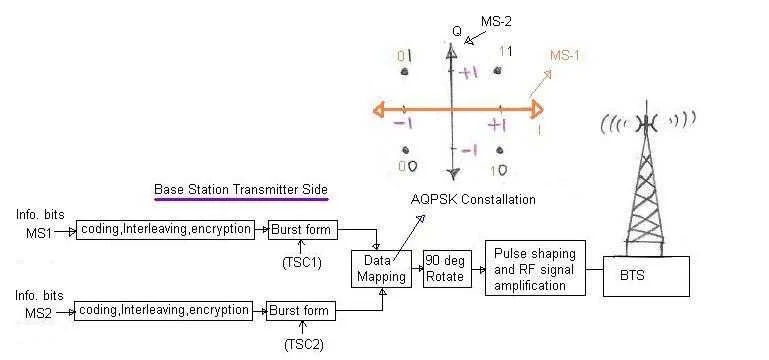VAMOS basics in GSM system
This page describes VAMOS basics in GSM system. VAMOS stands for Voice services over Adaptive Multi-user channels on One Slot. The idea here is to increase the voice calls capacity supported by GSM network. It is possible to use one time slot for four voice calls/services. It does not require any extra transmit/receive hardware to achieve this and will provide similar voice quality as normal GSM handset (non VAMOS handset).
With GSM full rate, 1 call per time slot is possible.
With GSM Half rate, 2 calls per time slot is possible.
With VAMOS in GSM half rate, 4 calls per time slot is achievable.
This tutorial on GSM covers following:
• GSM Frame Structure
• GSM Burst types
• GSM speech processing
• GSM Channel types-logical,physical
• GSM logical channels and mapping
• GSM Mobile network entry procedure
• GSM Mobile originated call flow
• GSM Mobile terminated call flow
• GSM Downlink PS Call
• GSM Uplink PS call
• GSM VAMOS Basics
• GSM AMR basics
• GSM noncombined channel configuration
• GSM combined channel configuration
• GSM Modulation types-MSK,GMSK
• GSM Physical Layer
• GSM Protocol Stack
• GSM Mobile Phone Basics
• GSM Radio Frequency Planning
How does VAMOS work?
Training sequence codes (TSCs) are unique to each mobile station using the same time slot hence it
helps segregate mobile stations at Base Station. These training sequences used in VAMOS are
different than one used in normal GSM handset. Under this concept two TSCs are allocated to each
Base Transceiver Station (BTS),
one for normal GSM case and the other for to provide/enable VAMOS capability in the existing network.
Interference rejection cancellation (IRC) is used to separate out calls from different mobiles at
base transceiver unit (base station). SAIC (Successive antenna interference cancellation)
is used at each mobile receiver to separate out its voice call from the one time slot.
Both SAIC and IRC will use TSC to perform the task.
Here a new modulation scheme is employed called AQPSK (Adaptive QPSK) where each symbol
carries data to two mobile stations. This modulation scheme is employed at Base station
(downlink) and meant to carry voice calls for two different mobile stations in one time slot.
In the uplink same GMSK is employed by all the Mobile Stations (MSs).
These terminals falls under VAMOS-I and need to meet less rigorous
performance specifications, which is SCPIR (sub channel power imbalance ratio)
of about -4 dB, 0 dB and 4 dB. VAMOS capable phones are also called DARP compliant.
DARP stands for Downlink Advanced Receiver Performance.
VAMOS-II capable handset terminals need to meet performance requirements, SCPIR
of about -8 dB and -10 dB. MIMO is also planned to incorporate in VAMOS-II for
diversity functionality.
VAMOS features can easily be incorporated in the existing network and both DARP
enable and non DARP enabled (legacy) handsets can co-exist in the GSM network.

The figure-1 describes VAMOS modules for transmissions to two mobile stations MS1 and MS2 in the downlink. Both uses different unique training sequences TSC1 and TSC2. Each QPSK symbol consists of data from two Mobile stations.

The figure-2 describes VAMOS modules for transmissions from mobile stations MS-1 and MS-2. Here both uses different Training Sequence codes TSC-1 and TSC-2, but both uses GMSK modulation.
VAMOS REFERENCEs
To know detail modules at Base station Transmitter and mobile station transmitter for changes regarding VAMOS refer 3GPP TS 45.001 V9.0.0 standard. Download the same from following link.
https://www.3gpp.org/ftp/Specs/html-info/45001.htm
VAMOS Capable or compliant Mobile Phones
Following companies have developed VAMOS capable or compliant Mobile Phones:
1. Ericsson
2. Nokia Siemens Network (NSN)
3. Renesas
RELATED LINKS
GSM Tutorial
GSM Physical layer
GSM Protocol stack
GPRS Tutorial
GPRS Protocol Stack
CDMA Tutorial
